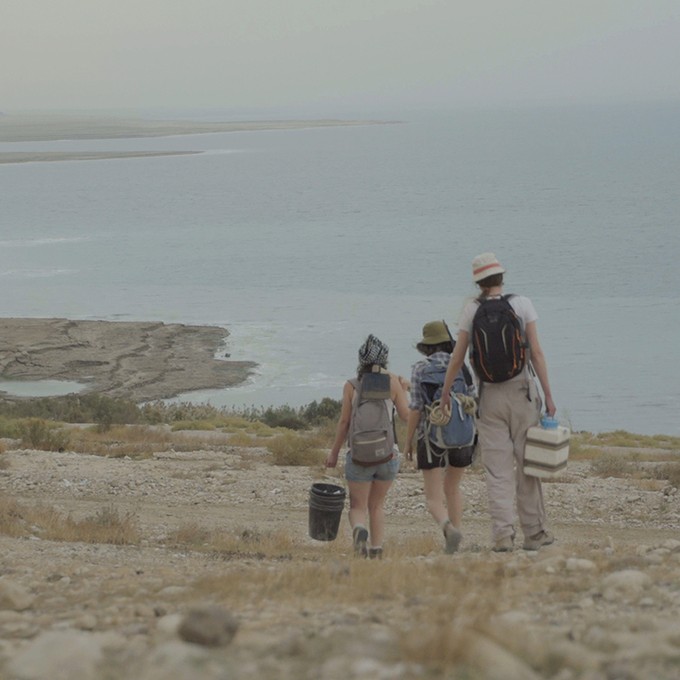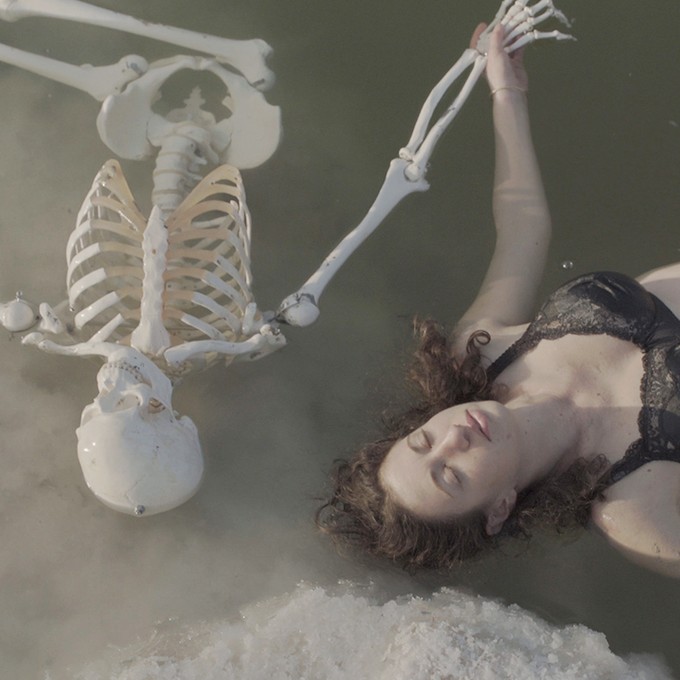Tamar Hirschfeld
Sheldon, Le Squelette Humaniste - Film - 30min - 2016
présenté dans le cadre de l'exposition Panorama 18



Film
Sheldon, a joyful, well educated, skeleton from the Dead Sea, is revived and brought to France by an Israeli archeologist. He visits a huge supermarket and encounters different aspects of the French lifestyle. He is impressed by the richness of the culture, but is also exposed to its destructive inner conflicts. During his journey, Sheldon flirts with his host and they fall in love. Their impossible love story ends in tragedy.
The film divided into four parts.
-
1.The Dead Sea. Three young women walk through the desert on a quest. On the shore of the Dead Sea, they start digging. They find a skeleton buried in the mineral mud. As the head of the team cleans it in the sea, a magical spell falls upon them and the skeleton wakes up.
-
2.The Supermarket. The skeleton wakes up in a huge supermarket in France, animated by two puppeteers dressed entirely in black. His name is Sheldon. Tamar, the Israeli girl, welcomes him to France. They walk up and down the aisles, exploring the wonders of the French culture. They start by tasting wine and cheese, and they enjoy the good life. They subsequently discover the less glamorous aspects of France. Sheldon is compassionate and always tries to help unfortunate people, and Tamar falls in love with his charm.
-
3.The Greenhouse. Tamar and Sheldon live the most beautiful part of their life in a greenhouse for exotic plants. They run around like children, look at the plants, play hide and seek, make love, reach an orgasm and fall asleep under a tree. The puppeteers seize the opportunity to leave.
-
4.The Studio. Black abyss, white mist. Tamar wakes up. Sheldon does not. The puppeteers are gone, and therefore he is no longer a man. Tamar takes the matter into her own hands. She revives Sheldon by covering him with raw meat. Will the lovers reunite?
Tamar Hirschfeld
Tamar Hirschfeld was born in Jerusalem in 1984, qualified with a Master's Degree at the Bezalel Academy of art and design, Jerusalem (Israel). She grew up in Jerusalem, a city rife with conflicting religions, nationalities, and ideologies. This reality has fuelled Tamar Hirschfeld's preoccupation with power relations. She has learned how to act in a stress-filled, conflict-ridden, binary environment.
From the beginning of her undergraduate studies in the city, she made it her goal to produce images based on ideological ambiguity. Hirschfeld uses extreme, hackneyed representations of religion, nationality, gender, and race, which she dialectically confronts with their opposites. This is her way of protesting against a binary perception of reality, one that requires us to choose a political party, a religious or national loyalty, and a clear gender identity, and thus upholding humanity. Hirschfeld’s work varies between installation, performance, drawing and film and has been presented at contemporary art events such as Tel Aviv, Petach Tikva and Herzelia Museums in Israel, and she received a grant from the Centre for Contemporary Art in Tel Aviv.
She is currently living and working in Tel Aviv as well as in Lille, where she is a student at Le Fresnoy, Studio national des arts contemporains.
Production
Acknowledgments
Special thanks to:
Guylaine Huet, Jeanne Lassus, Harel Luz, Hanna Hirschfeld, João Pedro Rodrigues, Charlie Megira
Gratitude deep:
Amos Holzman, Hagai Hirschfeld, Charlotte Bayer Broc, Sonia Evin, Souliman Schelfout, André Padilla Domene, David Duvshani, Manon Barrier, Arnaud Provoyeur, David Nisolle, Séverine Bachelet, Christophe Gadenne, Madeleine Van Doren, Daniel Dobbels and the gallery Givon Art Forum, Tel Aviv.
